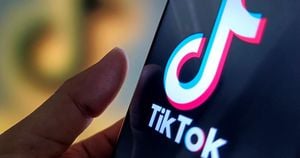Technology is rapidly transforming how consumers experience products and services, reshaping everything from shopping to personal entertainment. Among these advancements, tablets like the OnePlus Pad 2 highlight the interplay between performance and consumer expectations, particularly when it pertains to entertainment versus productivity.
The new OnePlus Pad 2 is garnering attention for its impressive display and sound capabilities. It features a sharp and bright 144Hz display, which enhances everything from streaming films to playing games. This astonishing performance is powered by the Snapdragon 8 Gen 3 mobile processor, making it one of the stronger contenders among midrange tablets on the market. Its screen resolution sits at 3000 x 2120, boasting peak brightness of 900 nits, which renders vivid colors and great contrasts, especially for indoor viewing.
But where the OnePlus Pad 2 shines as an entertainment device, it falters when transitioning to productivity. One of the selling points of the tablet is its newly introduced multitasking feature called Open Canvas, which allows users to run three apps simultaneously. While this might sound beneficial, the reality proves different. The app layouts tend to feel cramped, especially on larger displays, leading to headaches rather than ease. Critics say the productivity functionalities lack the sophistication found in rival brands like Apple or Samsung.
For people who utilize tablets for light work tasks, the OnePlus Pad 2 does offer functionality with productivity apps such as Google and Microsoft Office. Note-taking capabilities are enhanced, with options for different templates like bullet points or grids, catering to students or those who enjoy journaling. Yet, this isn’t enough for someone who thrives on multitasking or needs versatile solutions for their work.
A significant point to mention is the price, which many find steep for what the tablet offers. Priced at $549.99, it has come under scrutiny compared to competitors like the Samsung Galaxy Tab S9 FE Plus, which retails for just $50 more but includes features like cellular connectivity and superior software updates. The higher price coupled with the diminishing returns on productivity functions leaves potential buyers skeptical.
What is also noteworthy about the product is the impact of user agreements upon purchase. Each smart device requires users to agree to numerous terms of service, and the OnePlus Pad 2 is no exception. Potential users have to navigate through agreements like the OnePlus User Privacy Security and Protection agreement and the Google Terms of Service before being able to use their device. This raises questions about consumer rights and awareness as many individuals may rush through these documents without fully comprehending their ramifications.
While the OnePlus Pad 2 can entertain and thrill consumers with its display quality, the reality for productivity remains compromised and far from what most users might expect from such an investment. Continuous feedback from consumers will be pivotal for companies as they aim to meet ever-evolving expectations, all rooted deeply in the technological advancements available to them.
Similar struggles become apparent when we look at consumer engagement across various sectors. Businesses are now more interested than ever in integrating technology to refine customer experiences from the ground up. The focus has shifted toward creating seamless interactions—whether through online shopping, customer service, or product support. For example, AI-driven tools are on the rise, offering personalized interactions. This allows brands to anticipate needs and preferences, enhancing the overall purchasing experience.
Personalized shopping experiences through technology promise to be the wave of the future. Retailers are utilizing AI algorithms to analyze consumer data, leading to specially curated suggestions for individual customers. This personalization is not only aimed at enhancing purchasing efficiency but also at fostering brand loyalty.
Consider retailers using chatbots to assist customers. These AI tools can provide instant feedback and support—occupying the role of staff members to troubleshoot and resolve inquiries swiftly. Given the rapid pace at which technology moves nowadays, it’s clear consumers expect immediate results, and businesses must adapt. Failure to do so can mean lost customers, negative reviews, and dwindling sales figures.
On top of personalization, the role of omnichannel experiences is critical. Shoppers today no longer differentiate between physical and digital shopping interactions; they expect fluid transitions across platforms. Walkers might want to browse online and pick up at the store or order items via mobile apps. Retailers must meet these expectations, presenting products consistently across all channels to attract and retain customers.
The technology employed is not limited to improving direct sales or customer service. Companies today are making strides to innovate supply chains and logistics through tracking and automation. Real-time data allows retailers to maintain inventory transparency, optimizing the movement of goods from the manufacturer to the consumer. This efficiency can bolster the overall purchasing experience, minimizing errors, delays, and increasing satisfaction.
Even social media has carved out its niche, providing interactions and customer experiences focused on community-building and brand engagement. Platforms now enable businesses to connect with consumers on more personal levels, emphasized by user-generated content—like reviews, testimonials, and unboxings—that influences consumer behavior significantly.
So, where do we find ourselves amid this swirling change? The consumer experience is undoubtedly evolving, with many eager for greater interaction, personalization, and technology usage. The OnePlus Pad 2, for example, reflects just one slant of how technology intertwines with our day-to-day lives. Still, the balance between impressive entertainment offerings and productivity demonstrates the need for development and enhancement as brands respond to market demands.
Conclusively, the impact of technology on consumer experience is far-reaching and multifaceted. Brands need to pay attention to consumer feedback, exploring how they can adjust their offerings to accommodate shifts toward digital engagement, streamline communication, and anticipate needs. Only then can they thrive within this continuously changing tech-driven marketplace.



